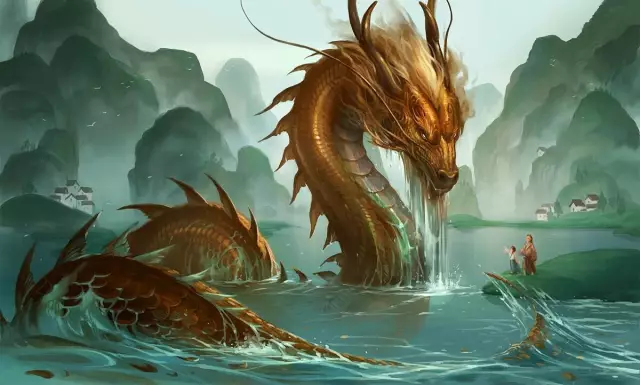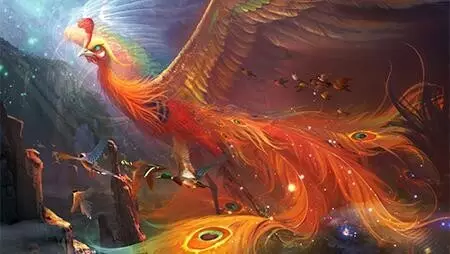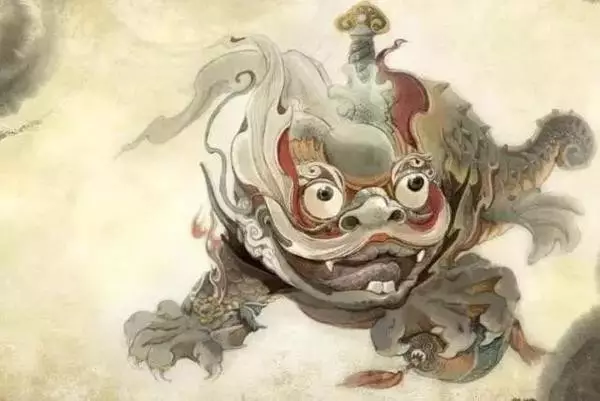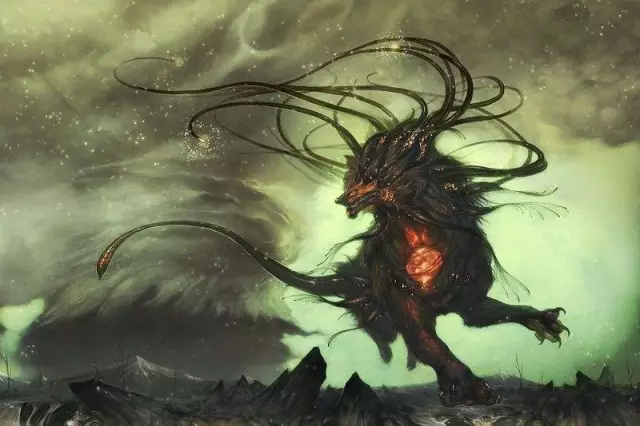Ruìshòu shì yuánshǐ rén qún tǐ de qīnshǔ、zǔxiān duì yú bǎohù shén de yì zhǒng chóngbài,shì rénlèi lìshǐ shàng zuì zǎo de yì zhǒng wénhuà xiànxiàng。
瑞兽是原始人群体的亲属、祖先对于保护神的一种崇拜,是人类历史上最早的一种文化现象。
Auspicious animals are the worship of patron saints by the primitive people, which is the earliest cultural phenomenon in human history.
Tā men cóng yuángǔ shídài yì zhí yáncún zhì jīn。Jīntiān , wǒmen jiù lái kàn yi kàn Zhòngguó lìshǐ shàng de wǔ dà ruìshòu shì shén me。
它们从远古时代一直沿存至今。今天,我们就来看一看中国历史上的五大瑞兽是什么。
Auspicious animals have kept existing from the ancient times to date. Today, we’d like to have a look at five auspicious animals in Chinese history.
1. 龙 lóng
Dragon

Lóng , zì gǔ wéi zhōnghuá mínzú de túténg , yǒu dìwáng de hányì 。 Zài Zhōngguó gǔdài , tóu yǒu liǎng zhī jiǎo de jiào zuò lóng , yì zhī jiǎo de jiào zuò jiāo ; méiyǒu jiǎo de jiào zuò chī 。
龙,自古为中华民族的图腾,有帝王的含义。在中国古代,头有两只角的叫做龙,一只角的叫做蛟;没有角的叫做螭。
Dragon has been the totem of the Chinese since the ancient times. It’s the symbol of emperors. In ancient China, a dragon with two horns was called “龙” (long), a dragon with one horn was called “蛟”, and a dragon without horns was called “螭” (li).
Lóng zài mínjiān bǐ yù nánzǐ , mùqián yǐ chéngwéi huárén xīnmù zhōng zuì zūnguì de jíxiáng wù dàibiǎo , yǒu shénwǔ 、 lìliàng 、 zhuóyuè 、 cáifù de xiàngzhēng 。
龙在民间比喻男子,目前已成为华人心目中最尊贵的吉祥物代表,有神武、力量、卓越、财富的象征。
“龙” is a folk metaphor of men. It is now the most auspicious mascot for the Chinese. It symbolizes power, brilliantness and fortune.
2. 凤凰 fèng huáng
Phoenix

Fènghuáng , shì “ niǎo zhōng zhī wáng ” , yě shì Zhōngguó gǔdài zuì zhùmíng de jíxiáng niǎo , shí èr shēngxiāo lǐ jī de yuánxíng jiù shì fèng huáng , shì huánghòu de xiàngzhēng 。
凤凰,是“鸟中之王”,也是中国古代最著名的吉祥鸟,十二生肖里鸡的原型就是凤凰,是皇后的象征。
Phoenix is the “king of birds” , as well as the best known auspicious bird in ancient China. It is the prototype of rooster in the Chinese zodiac signs. It is the symbol of empresses.
Jǐ qiān nián lái , fènghuáng zài Zhōngguó rén mín de xīn mù zhōng , yì zhí bèi shì wéi měilì 、 jíxiáng 、 shànliáng 、 děng xiàngzhēng 。
几千年来,凤凰在中国人民的心目中,一直被视为美丽、吉祥、善良、等象征。
For thousands of years, it has been implying beauty, auspiciousness and goodness for the Chinese.
3. 龟 guī
Turtle

Guī , guībèi de wénlǐ mìjí , Zhōngguórén yì zhí xiāngxìn , guī yǐncáng zhe tiāndì de mìmì , yīncǐ tā yě chéngwéi yì zhǒng shénmì ér fùyǒu wén huà nèihán de dòngwù 。
龟,龟背的纹理密集,中国人一直相信,龟隐藏着天地的秘密,因此它也成为一种神秘而富有文化内涵的动物。
A turtle has dense texture on its back. The Chinese have been convicted that a turtle carries the secrets about the heaven and the earth, so it has become a mysterious animal with rich cultural connotations.
Tóngshí , gèng shì yīnwèi guī shòumìng jí cháng , suóyǐ chéng le chángshòu de xiàngzhēng 。
同时,更是因为龟寿命极长,所以成了长寿的象征。
Meanwhile, due to its long life, it has also become the symbol of longevity.
4. 貔貅 pí xiū
Pixiu

Píxiū yòu míng bìxié 。 Shì Zhōngguó gǔdài shénhuà chuánshuō zhōng dì yì zhǒng shénshòu , lóng tou 、 mǎ shēn 、lín jiǎo ,xíngzhuàng sì shīzi , máosè huī bái , huì fēi 。
貔貅又名辟邪。是中国古代神话传说中的一种神兽,龙头、马身、麟脚,形状似狮子,毛色灰白,会飞。
Pixiu, also called Pixie, is a divine animal in Chinese ancient myths. It has a dragon head, a horse body and kylin feet. It looks like a lion with white hair, and it flies.
Píxiū shì gǔdài ruìshòu , yě shì Zhōngguó de sān dà zhāocái ruìshòu zhī yī , zuǐ hán jīnqián de píxiū kǒu dà dù dà , mínjiān yòu yǒu shuōfǎ rènwéi píxiū méi yǒu gāngmén , zhǐ jìn bù chū , suóyǐ shuō jì néng zhāocái yòu kě shǒuhù cáifù 。
貔貅是古代瑞兽,也是中国的三大招财瑞兽之一,嘴含金钱的貔貅口大肚大,民间又有说法认为貔貅没有肛门,只进不出,所以说既能招财又可守护财富。
It is one of the auspicious animals in ancient China as well as one of the three fortune animals in China. With gold coins in its big mouth, it has a large stomach as well. It’s believed by the Chinese that it has not an anus, so it just takes in something and never lets it out. As a result, it becomes the symbol of a fortune maker and guardian.
5. 麒麟 qí lín
Kylin

Qílín yǔ píxiū 、 fèng 、 lóng 、 guī bìng chēng wéi “ wǔ líng ” ,qiě qílín wéi wǔ líng zhī shǒu 。Zǎo zài zhōucháo shí , wǒ guó jiù yǒu qílín de chuánshuō 。
麒麟与貔貅、凤、龙、龟并称为“五灵”,且麒麟为五灵之首。早在周朝时,我国就有麒麟的传说。
Kylin, Pixiu, phoenix, dragon and turtle are called “Five Spirits” collectively, and kylin is ranked at the top. As early as in Zhou Dynasty, there were legends about kylin.
Chuánshuō zhōng qílín xìng géwēn liáng , shì yǒu déxíng de rénshòu , yīncǐ , lìdài dìwáng dōu ài lín , bǎ tā de chūxiàn shì wéi guó zhī qíruì 。
传说中麒麟性格温良,是有德行的仁兽,因此,历代帝王都爱麟,把它的出现视为国之奇瑞。
According to the legends, kylin is a gentle and virtuous animal, so Chinese emperors of all dynasties were quite fond of it and took it as an unique auspicious sign of the nation.



 闽公网安备 35020302035673号
闽公网安备 35020302035673号
0 responses on "Five Auspicious Animals of Ancient China"